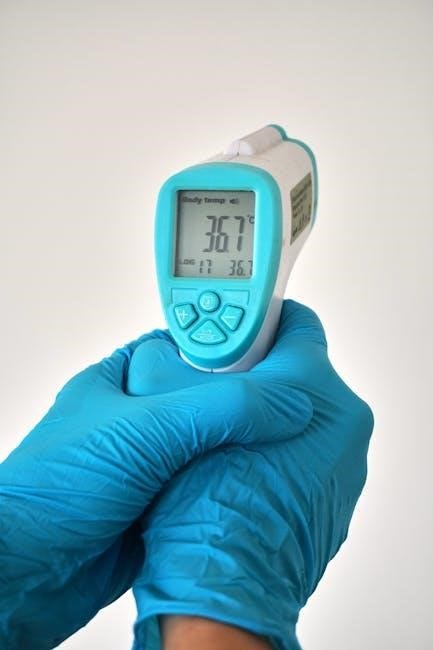A basal body temperature (BBT) chart is a tool used to track daily temperature readings, helping identify ovulation patterns and menstrual cycle trends. It involves recording your temperature each morning before rising and plotting it on a graph, often in PDF format, to visualize changes over time. This method is popular for fertility awareness and health monitoring, as it provides clear visual cues about your body’s hormonal shifts. By shading boxes or connecting dots, you can easily spot dips and spikes, making it easier to understand your cycle and plan accordingly. Regular use of a BBT chart can enhance your understanding of reproductive health and support fertility goals effectively.
What is Basal Body Temperature (BBT)?
Basal Body Temperature (BBT) refers to your body’s resting temperature, typically measured immediately upon waking after a full night’s sleep. It is the lowest temperature your body reaches during rest and is influenced by hormonal changes throughout your menstrual cycle. Measured using a basal thermometer, BBT is usually taken orally or under the armpit and recorded on a chart to track subtle fluctuations. These readings provide insights into physiological processes, such as ovulation and metabolic activity, and are often used for fertility monitoring and health assessment. Accurate BBT measurements require consistency and proper technique to ensure reliable data for charting purposes.
Importance of Tracking BBT for Fertility and Health
Tracking Basal Body Temperature (BBT) is crucial for understanding fertility patterns and overall health. It helps identify ovulation timing, confirm cycle phases, and detect hormonal imbalances. By monitoring BBT, individuals can gain insights into their menstrual health, aiding in fertility planning or contraception. Consistent tracking also supports early detection of potential health issues, such as thyroid dysfunction or irregular cycles, making it a valuable tool for reproductive and metabolic well-being. Regular BBT charting enhances awareness of bodily changes, empowering informed decisions about health and fertility goals.
How to Use a Basal Body Temperature Chart
Start your BBT chart on Day 1 of your menstrual cycle. Record your temperature daily upon waking and plot it on the grid. Note any factors affecting readings.
Step-by-Step Guide to Recording Your BBT
Start by taking your temperature immediately upon waking, before any activity, using a basal thermometer. Record the reading on your BBT chart, shading the corresponding temperature box. Note the date and day of your menstrual cycle. Connect the shaded boxes with a line to track trends. If factors like restless sleep or illness affect readings, mark them on the chart. Begin a new chart each cycle for accurate tracking.
Tools and Thermometers Required for Accurate Measurements
A basal thermometer, preferably digital, is essential for precise readings. Choose one designed for BBT tracking, as it offers finer temperature gradations. A printable BBT chart in PDF format is necessary for recording data. Optional tools include online charting platforms like OvaGraph for digital tracking. Ensure the thermometer is used consistently, either orally or axillary, for uniform results. Proper tools are vital for accurate and reliable basal body temperature measurements.
Understanding Basal Body Temperature Patterns
Basal body temperature patterns reveal hormonal changes throughout your cycle. Typically, temperatures are lower pre-ovulation and rise post-ovulation. This shift confirms ovulation, aiding fertility tracking and cycle understanding.
Normal BBT Ranges and Variations
Normal basal body temperature (BBT) typically ranges from 97.2°F to 97.7°F before ovulation and rises to 97.8°F to 98.2°F after ovulation. Minor variations may occur due to factors like sleep quality, health conditions, or hormonal changes. Tracking over cycles helps identify personal norms, as individual baselines can differ slightly. Consistent recording ensures accurate pattern recognition, aiding in fertility planning and health monitoring. Regular fluctuations are normal, but significant deviations may warrant medical consultation.
How BBT Relates to Ovulation and Menstrual Cycles
Basal body temperature (BBT) reflects hormonal changes throughout the menstrual cycle. Before ovulation, BBT is typically lower, ranging from 97.2°F to 97.7°F. After ovulation, progesterone levels rise, causing BBT to increase by 0.4°F to 1.0°F. This temperature shift helps confirm ovulation and identify the fertile window. Tracking BBT over cycles provides insights into menstrual health, aiding in fertility planning and understanding reproductive patterns. Consistent monitoring enhances accuracy in detecting ovulation timing and cycle regularity.

Factors Affecting Basal Body Temperature
Factors such as sleep disturbances, illnesses, alcohol consumption, and medications can influence basal body temperature readings, affecting their accuracy and reliability in tracking menstrual cycles and ovulation.
Common Influences on BBT Readings
Basal body temperature readings can be influenced by various factors, including sleep quality, alcohol consumption, medications, and stress levels. Additionally, environmental changes, such as room temperature or travel, can also impact readings; It’s important to note these factors on your chart to ensure accurate tracking and avoid misinterpretation of natural fluctuations. Consistency in measurement techniques and timing helps minimize external influences and provides reliable data for understanding your cycle.
How to Minimize Variations for Accurate Tracking
To ensure accurate basal body temperature tracking, maintain a consistent routine: take readings at the same time daily, before rising, and use a high-quality basal thermometer. Avoid disruptions like alcohol, late nights, or travel, which can affect results. Keep your thermometer in the same location and ensure adequate sleep. Document any factors that might influence readings, such as stress or medications, to refine your chart’s reliability and interpret trends more effectively.

Interpreting Your Basal Body Temperature Chart
Analyzing your basal body temperature chart helps identify ovulation patterns, confirming when ovulation occurs. Look for temperature dips before ovulation and sustained spikes post-ovulation, indicating cycle phases.
Identifying Ovulation and Fertility Windows
Your basal body temperature chart is a key tool for detecting ovulation and determining fertility windows. A noticeable dip in temperature often signals impending ovulation, followed by a sustained rise post-ovulation. This shift typically indicates that ovulation has occurred, helping you pinpoint your fertile period. By analyzing the chart, you can identify the days when conception is most likely, making it an effective method for fertility planning and monitoring menstrual health. Regular tracking enhances accuracy, ensuring reliable insights into your cycle patterns.
Understanding Dips, Spikes, and Trends in BBT
Your BBT chart reveals distinct patterns, with dips and spikes indicating hormonal changes. A pre-ovulatory dip is often followed by a rise after ovulation, confirming it occurred. Trends show consistent low temperatures before ovulation and higher post-ovulation. These patterns help identify fertile windows and cycle phases. Variations may occur due to factors like sleep disruptions or health changes. Consistent tracking ensures accurate insights into your body’s natural fluctuations and reproductive health.
Benefits of Charting Basal Body Temperature
Charting BBT enhances fertility awareness, aids in family planning, and provides insights into menstrual health. It helps identify ovulation, monitor cycle regularity, and detect potential health issues early.
Using BBT for Fertility Awareness and Planning
Tracking BBT helps identify ovulation, enabling precise fertility planning. By monitoring temperature shifts, you can determine your fertile window, crucial for conception or birth control. BBT charts provide clear visual cues, such as post-ovulatory rises, helping you understand cycle patterns. This method empowers you to make informed decisions about family planning and enhances awareness of reproductive health. Regular charting also supports long-term fertility goals effectively.
Monitoring Health and Detecting Potential Issues
Basal body temperature charts are valuable for monitoring health and detecting potential issues. Consistent tracking can reveal underlying conditions like hypothyroidism or infections, as these often cause temperature fluctuations. Unexplained spikes or persistent deviations from your normal range may indicate health concerns. Regular charting allows early detection of anomalies, prompting timely medical consultation. This tool not only aids fertility planning but also serves as a proactive approach to maintaining overall well-being and identifying health trends. Regular monitoring ensures early intervention if issues arise.
Basal Body Temperature Chart Templates and Resources
Find downloadable basal body temperature chart PDFs online, designed for easy tracking. Use templates from platforms like OvaGraph or print customizable charts to suit your needs.
Where to Find Printable BBT Chart PDFs
Printable basal body temperature (BBT) chart PDFs are widely available online. Platforms like OvaGraph and fertility-focused websites offer downloadable templates. Health apps such as Clue and Fertility Friend often provide PDF exports for easy printing. Additionally, marketplaces like Etsy have digital products featuring customizable BBT charts. Non-profit health organizations and educational websites may also offer free, reliable templates. Searching with keywords like “printable BBT chart PDF” can yield numerous options, ensuring you find one that suits your tracking needs effectively.
Customizing Your Chart for Personal Use
Customizing your basal body temperature (BBT) chart PDF allows you to tailor it to your specific needs. You can add personal details like your name, cycle dates, and notes about health or symptoms. Some templates let you color-code phases, such as pre-ovulation and post-ovulation, for better visualization. Digital tools like Adobe Acrobat or online PDF editors can help you modify the chart. Including a legend or key ensures clarity. Tailoring the design improves usability and alignment with your fertility tracking goals.

Troubleshooting Common Issues
Common issues with BBT tracking include inaccurate readings from poor sleep or illness. Ensure consistent measurement methods and review charts regularly to identify and address errors promptly for reliable data.
Addressing Inaccuracies in BBT Readings
Inaccuracies in BBT readings often stem from inconsistent measurement times, poor sleep quality, or external factors like illness. To ensure accuracy, take readings at the same time daily, use a basal thermometer, and avoid disturbances. If irregularities persist, consult a healthcare provider to rule out underlying health issues. Keeping detailed notes and cross-referencing with cervical mucus observations can also help validate BBT trends and improve tracking reliability over time.
Solving Problems with BBT Charting
Common issues with BBT charting include inconsistent readings, forgotten measurements, or misinterpretation of data. To resolve these, establish a daily routine, use a reliable basal thermometer, and ensure adequate sleep. If readings remain inconsistent, consider external factors like stress or illness. For persistent issues, consulting a healthcare provider can provide clarity. Regular practice and careful documentation are key to improving accuracy and gaining meaningful insights from your BBT chart over time.

Integrating BBT Charting with Fertility Awareness Methods
Combining BBT charting with fertility awareness methods enhances understanding of menstrual health. By tracking temperature alongside cervical mucus and ovulation symptoms, you gain a holistic view of your cycle, aiding in fertility planning and natural family planning effectively.
Combining BBT with Other Fertility Signs
BBT charting is most effective when combined with other fertility signs, such as cervical mucus observations, ovulation predictor kits, and physical symptoms like mittelschmerz. By correlating temperature shifts with mucus patterns and hormonal changes, you gain a clearer picture of your cycle. This integrated approach helps pinpoint ovulation more accurately and identifies your fertile window. Using a basal body temperature chart alongside these methods enhances fertility awareness and supports natural family planning or pregnancy achievement. Regular tracking ensures a comprehensive understanding of your reproductive health.
Enhancing Your Understanding of Menstrual Health
Tracking basal body temperature (BBT) enhances your understanding of menstrual health by revealing cycle patterns, hormonal changes, and ovulation timing. Regular BBT charting helps identify irregularities, such as anovulatory cycles or potential thyroid issues, early. This awareness allows for timely medical consultation and informed decisions about reproductive health. By monitoring your BBT and correlating it with physical symptoms, you gain deeper insights into your menstrual cycle and overall wellness, empowering proactive health management.